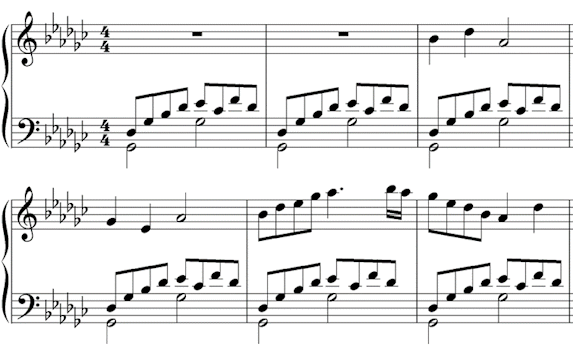Writing keyboard accompaniments is probably a task you have not done very often, so in this lesson we will look at some of the typical types of accompaniments often found in Classical-style keyboard pieces (c. 1750-1830). Musical periods overlap, and, of course, styles do not change overnight, so earlier Classical pieces are often stylistically similar to late Baroque, and later Classical pieces are similar to early Romantic.
Earlier keyboard styles are often polyphonic, which means there are two or more rhythmically independent melodies woven together, for example this Rigaudon by Rameau (1683-1764). Notice how the left hand echoes the right, four beats later. “Counterpoint” is the art of combining individual melodies. There is no separate accompaniment, because each melody is equally important.

Baroque music can also be built of a melody with simple bass line accompaniment, for example this Intrada (like a Prelude), by Handel (1685-1759). Notice here that the left hand is not considered to be “consecutive octaves”, because we do not have a separate tenor part. Instead, the bass line is simply being doubled up at the octave to create a thicker sound. Doubled octaves are very common in piano music.

The polyphonic style became less popular during the Classical era, although it was still used from time to time. Instead, the homophonic style became fashionable. Homophonic music uses one main melody, with a less important accompaniment.
In this Waltz, Schubert (1797-1828) uses chords in the left hand, as well as occasionally harmonising the melody in thirds in the alto part.

Broken-chord patterns were also common in the Classical era, for example in this character piece called Traurig (Sad) by Beethoven (1770-1827). This type of accompaniment is also called “Alberti bass”.

In broken-chord patterns, it is usually the lowest note of each chord which defines the inversion. Second inversion chords can only be used in the usual specific places; however, the “arpeggio 6/4” is widely used in this pattern.
Here, (Fuchs, Op.47 no.4) the first C major chord should be considered to be in root position, not second inversion. The following F major chord is in second inversion (arpeggio 6/4). If a downward pattern is used, it is possible that the first note in each group forms a tenor part. (Notice the stems up part on the bass clef stave).

Harmonising the melody with a tune in another part usually happens in either 3rds or 6ths, for a fuller sound (rather than 4ths, 5ths, or octaves). Harmonisation can also be combined with chords or sustained/repeated notes for a thicker texture. As we move into the later Classical/early Romantic era, thicker textures become more fashionable.
Here, Cui (1835-1918) harmonises with the melody first in the bass part (in 3rds), and then in the tenor (in 6ths), in this piece called Au Berceau (In the Cradle). The other parts fill out the harmony into a 4-part texture.

An ostinato is a repeated pattern which underpins the melody, for example in this Berceuse (Lullaby) by Ilinsky (1859-1920). The repeated pattern is in the tenor part and lasts for one bar each time. The melody begins in the right hand in bar 3, and the bass has a tonic pedal throughout this section.
